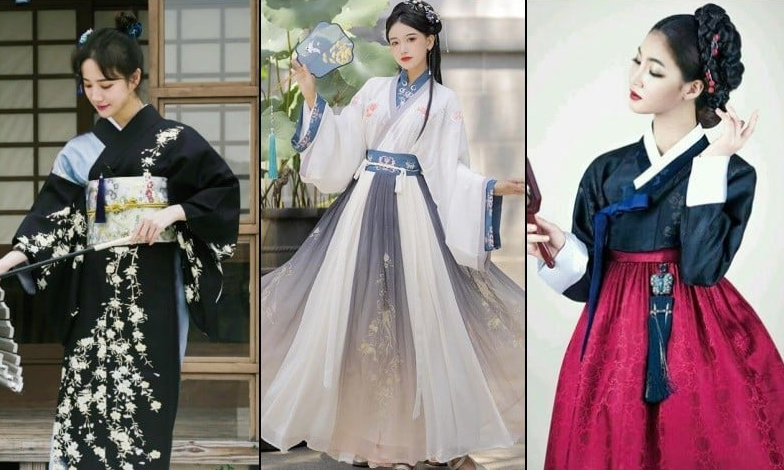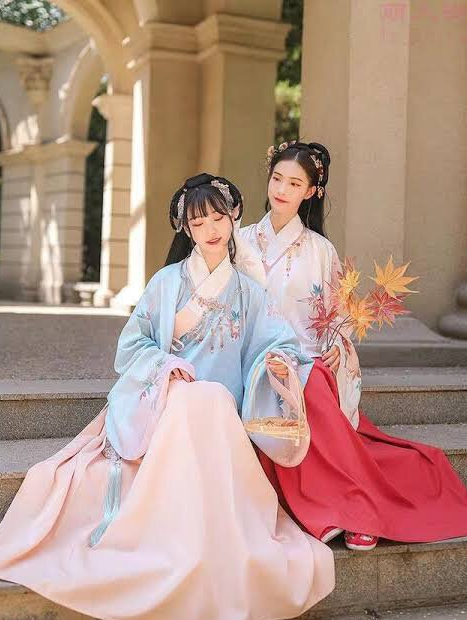Hanfu, hanbok, and kimono are traditional garments from China, Korea, and Japan, respectively, each with distinct designs, cultural significance, and historical backgrounds.
Historical Background
Origins of each clothing type
- Hanfu (China) The Hanfu traces its origins to the Han Dynasty, a significant period in Chinese history. It is believed that the Hanfu represents the historical and cultural clothing of the Han people. Over various dynasties, the designs and styles of Hanfu evolved to suit the times and the ruling dynasty’s preferences. For an in-depth look at its historical trajectory, consider visiting the Hanfu Wikipedia page.
- Hanbok (Korea) The Hanbok, Korea’s traditional dress, has its roots in ancient Korean history. The unique design, characterized by its vibrant colors and simple lines, has been worn by Koreans for centuries. The Hanbok’s design, especially the jeogori (jacket) and chima (skirt), remains largely consistent throughout history, with minor variations. Delve deeper into its history on the Hanbok Wikipedia page.
- Kimono (Japan) The Kimono is a timeless symbol of Japanese culture. Originating in the Heian period, the Kimono’s design was influenced by Chinese garments before it evolved into its distinct style. Made from fine silks and intricate patterns, the Kimono was a marker of status and identity in historical Japan. Discover more details about its evolution on the Kimono Wikipedia page.

Cultural significance over the centuries
- Hanfu (China) Beyond its aesthetic appeal, the Hanfu held profound cultural and societal implications. Depending on the design and color, it could signify one’s social status or profession. Additionally, specific ceremonies or festivals demanded particular styles of Hanfu.
- Hanbok (Korea) Beyond daily wear, the Hanbok played an integral role in Korean ceremonies like weddings, funerals, and ancestral rites. The garment’s colors and designs often had symbolic meanings, such as conveying blessings, good fortune, or expressing grief.
- Kimono (Japan) The Kimono is not merely a piece of clothing but a representation of Japanese art, history, and culture. Historically, the choice of kimono, from its color to its pattern, would convey various meanings, such as seasons, age, marital status, or even personal messages. Wearing a specific type of kimono during festivals or ceremonies was also a common practice.
Design and Structure
Hanfu (China)
The Hanfu has a rich variety of designs, which have evolved over different Chinese dynasties. Common components include the cross-collared robe, long flowing sleeves, and layered garments. The design often emphasizes a loose form, allowing ease of movement.
- Fabrics and Patterns: Silk is a predominant material for traditional Hanfu, reflecting China’s renowned history of silk production. The patterns often showcase auspicious symbols, mythical creatures, and floral designs. Check out the intricate patterns on the Hanfu Wikipedia page.
- Clothing Types: There are various types of Hanfu like the Quju, Shenyi, and Pao, each distinct in its cut, length, and wearing style.
Hanbok (Korea)
The Hanbok’s design is recognized for its grace and beautiful, simple lines. It consists mainly of two parts: the jeogori (a short jacket) and chima (a full, wrap-around skirt) for women, or baji (pants) for men.
- Colors and Symbolism: Hanbok colors often have symbolic meanings, with various shades representing different virtues or elements. For instance, the color white, frequently used in Hanboks, represents purity and integrity. Discover the symbolism of colors on the Hanbok Wikipedia page.
- Accessories: Hanbok is often accompanied by accessories like the norigae, a decorative pendant hanging from the jeogori, enhancing the outfit’s beauty.
Kimono (Japan)
The Kimono is a T-shaped garment, known for its long sleeves and straight seams. It is wrapped around the body with the left side over the right and secured by a sash called an obi.
- Types and Occasions: There are various types of kimonos, each suitable for different occasions. For example, a Furisode, with its long swinging sleeves, is worn by unmarried women, while a Yukata, a lighter cotton version, is worn during summer festivals. Dive into the different types on the Kimono Wikipedia page.
- Patterns and Seasons: The patterns on a kimono can change with the seasons. Cherry blossoms, for instance, are popular in spring, while maple leaves might be showcased in autumn designs. The pattern often gives clues to the wearer’s age, status, and personal tastes.
Cultural Significance
Hanfu and its representation in Chinese culture
The Hanfu isn’t just a piece of clothing but a symbol of Chinese heritage and civilization. Its designs, patterns, and wearing style have evolved over the dynasties, each reflecting the aesthetics and values of the time.
- Dynastic Reflection: Each dynasty in China, from the Tang to the Ming, had its unique Hanfu style that mirrored its socio-political and cultural ethos.Learn more about these interactions on the Silk Road Wikipedia page.
- Festivals and Rituals: The Hanfu plays a pivotal role in traditional Chinese festivals and ceremonies. For instance, during the Qixi Festival, often dubbed the ‘Chinese Valentine’s Day,’ many participants wear Hanfu to honor ancient customs and tales associated with the festival.
Hanbok’s role in Korean ceremonies and festivals
The Hanbok holds a dear place in the hearts of Koreans and is integral to various cultural ceremonies, celebrations, and rituals.
- Life’s Milestones: From a baby’s first birthday (Doljanchi) to weddings and even funerals, the Hanbok is donned as a testament to its cultural relevance across life’s significant events. Explore more about Doljanchi on the Doljanchi Wikipedia page.
- Lunar New Year: Seollal, or the Korean Lunar New Year, sees families dressed in Hanboks as they gather to honor ancestors, perform traditional games, and share a feast.
Kimono’s importance in Japanese traditions
- Tea Ceremonies: The traditional Japanese tea ceremony, known as the Way of Tea, often requires participants to wear kimonos, showcasing respect for the ritual and its historical significance. Delve deeper into this intricate ceremony on the Way of Tea Wikipedia page.
- Festivals: Events like Tanabata, a star festival, and Hinamatsuri, the doll’s day or girl’s day, often see participants dressed in vibrant kimonos that resonate with the spirit of the celebration. These garments not only add color to the festivities but also ground them in traditional Japanese aesthetics and values.
Modern Adaptations and Trends
Fusion and contemporary versions of the clothing
As the world becomes more interconnected, traditional garments are undergoing creative reinterpretations, blending age-old designs with modern aesthetics.
- Hanfu Revival: In recent years, a resurgence of interest in Hanfu has been seen among young Chinese, leading to innovative designs. Many now combine Hanfu elements with modern fashion, creating a stylish blend of past and present. Festivals, especially, see a display of these contemporary Hanfu styles.
- Hanbok in Daily Wear: Modern Hanbok adaptations are becoming increasingly popular in Korea. These versions, while maintaining the original grace of the Hanbok, are tailored for everyday comfort and versatility. Designers like Hwang Yi-seul have transformed the Hanbok into contemporary fashion pieces. Learn more about this trend on the Modern Hanbok Wikipedia page.
- Kimono Inspired Outfits: Japan sees a fusion where kimonos get a modern twist, be it shorter lengths, different fabrics, or new patterns. Yukatas, the lighter summer versions of kimonos, especially get playful reinterpretations and are a hit during summer festivals.
Popularity in international fashion
The global fashion scene has increasingly embraced the aesthetics of these traditional garments, acknowledging their rich history and unparalleled elegance.
- Runway Inspirations: Designers from around the world, like Yohji Yamamoto or Alexander McQueen, have showcased collections inspired by the kimono, Hanfu, or Hanbok. These designs often make headlines at international fashion weeks, underlining their global appeal.
- Celebrity Influence: Numerous international celebrities have been spotted wearing modern adaptations of these traditional outfits, contributing to their global recognition and appeal. For instance, the Met Gala has seen stars donning outfits inspired by these Eastern classics.
- Global Collaborations: Many global brands collaborate with Asian designers to release collections that blend traditional designs with contemporary fashion. Such collaborations often become instant hits, bridging cultural gaps and introducing these traditional garments to a broader audience.
Caring and Preservation
How to care for each traditional attire
Ensuring the longevity of these garments demands specific care methods tailored to their unique fabrics and designs.
- Hanfu Maintenance: Hanfu, often made of silk or brocade, requires gentle hand-washing using cold water. Avoiding direct sunlight when drying is essential to prevent color fading. When storing, it’s best to use cloth garment bags that allow the fabric to breathe. A deeper dive into fabric care can be found on the Silk care Wikipedia page.
- Hanbok Upkeep: Hanboks, due to their delicate fabrics and vibrant colors, should be dry-cleaned. Keeping them in a cool, dry place and ensuring they are aired out occasionally helps maintain their pristine condition.
- Kimono Care: Like the Hanbok and Hanfu, kimonos need special care. It’s recommended to unfold and air them out periodically to prevent mold or a musty smell. They should ideally be dry-cleaned or carefully hand-washed. When storing, traditional wooden kimono hangers and breathable fabric covers work best.

Preservation techniques and importance
Maintaining these garments is not just about aesthetic appeal but preserving cultural heritage and the craftsmanship involved in their creation.
- Storing with Herbs: Traditional preservation often involves storing these outfits with natural herbs or wood blocks, like cedar, which deter pests and impart a fresh scent.
- Museum Conservation: Many antique pieces of these traditional garments find their way to museums, where they undergo specialized preservation processes. These might involve temperature and humidity-controlled environments and specific light exposures to ensure they remain in pristine condition. Learn more about this meticulous process on the Textile conservation Wikipedia page.
- Passing Down Generations: One of the most potent preservation techniques is the tradition of passing these garments down through generations. They become family heirlooms, telling stories of ancestors and preserving family histories. This practice not only maintains the physical garment but also keeps the cultural significance and stories alive.